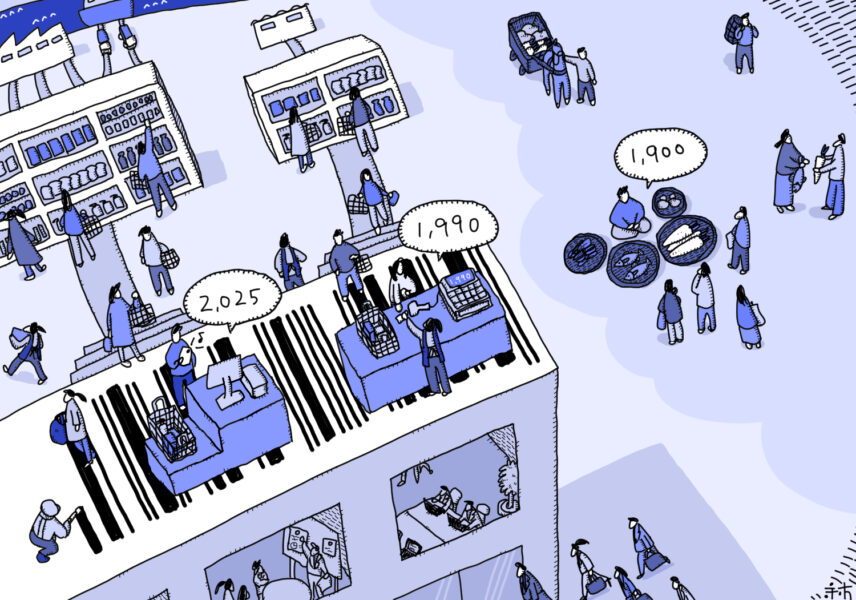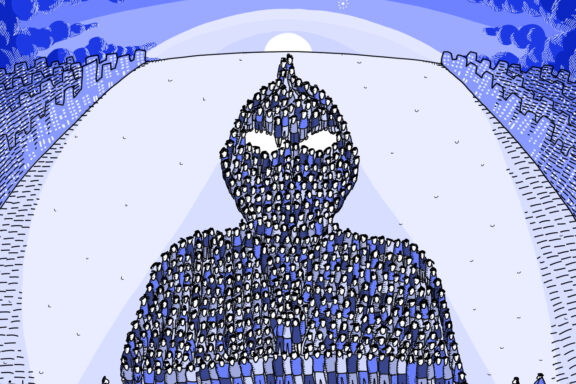Tomohiro Machikita (Labor Economics and Industrial Development)
Increasing numbers of stores are installing self-checkouts recently. The customer places the basket with the goods on one side of the self-checkout and hangs a shopping bag on the hooks on the other side. The barcode on each item is then passed in front of the black window on the checkout. If you hear a “beep,” the checkout has registered the purchase, but sometimes you can get hung up if you can’t find the barcode on the item. My interest in barcodes grew when I compared the skill of the checkout operator with my rotating of boxes in search of barcodes.
Barcodes first appeared in the mid-1970s. They consist of a vertical array of bars of differing widths inside an oblong, with a 12-digit product identification number, called a UPC (Universal Product Code), printed directly below it. The idea at the time was for a striped pattern of concentric circles, but it was found that an oblong shape was more easily machine readable, so that is what we have today. Fifty Things that Made the Modern Economy by Tim Harford gives special mention to this striped pattern as one of the fifty inventions that has changed our lives. The idea of combining bars of differing widths to store data is indeed a stunning one, but what is it about the barcode that makes it an innovation that formed the modern economy?
The manufacturer bears the cost of printing the barcode on a product, but the cost of installing the checkout and associated scanner is borne by the retailer or wholesaler. Unless the retailers and wholesalers introduce scanners, the manufacturers will not bear the printing cost. For retailers and wholesalers, if only very few manufacturers print barcodes on their products, the purchase of expensive scanners and systems would simply represent a loss. Economics has analyzed these distribution channels using the concept of network effects. According to research[1] on US manufacturers up to the early 1990s, it was found that the more retailers and wholesalers installed the system the more manufacturers printed barcodes on their product labels. The research also showed that trademark registrations, profits, and firm size increased following barcode adoption by manufacturers.
Why, then, did the diffusion of scanners begin on the retailer and wholesaler side? Thinking about who profits will perhaps give us a hint. According to Tim Harford’s book, this would be supercenters, of which the US Walmart is representative. Barcodes were firstly applied to foodstuffs. With the introduction of barcodes and scanners, stock management of food products was automated, reducing at a stroke the costs necessary to maintain a varied sales lineup and accelerating store integration and gigantification. Further, while it may not have been anticipated in the early days of the 1970s, the spread of scanners in distribution channels facilitated the entry of foreign goods into the market and encouraged the internationalization of supply chains. The involvement of the apparel industry with barcodes came later, but as competition became more intense, barcodes enabled Walmart to seek out Chinese suppliers more easily, which would make it easier for consumers to purchase low-priced goods.
What happens to whom when innovative technology appears in society? Tim Harford’s book, while illustrating in detail the technological factors behind specific inventions, takes a deep dive into explaining why they changed our lives for better or worse. Inventions lead on to further inventions, causing shifts in the prices of goods and services. Changes in prices alter power relations among players as well as the composition of the players, also resulting in unintended pervasive consequences. This book teaches us that the repetition of this experience is the history of humankind seen from the perspective of inventions.
Note
[1] Emek Basker and Timothy Simcoe. Upstream, Downstream: Diffusion and Impacts of the Universal Product Code, Journal of Political Economy, 2021 129:4, 1252-1286. See also VoxEU Summary of the paper.
(Illustration: Atelier Epocha)
This article is also available in Japanese. >>
「バーコードの予期せざる帰結」
(町北朋洋)






